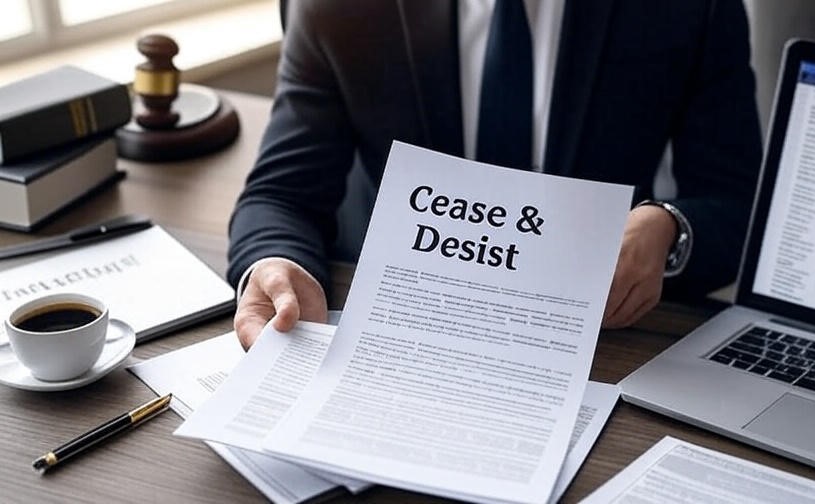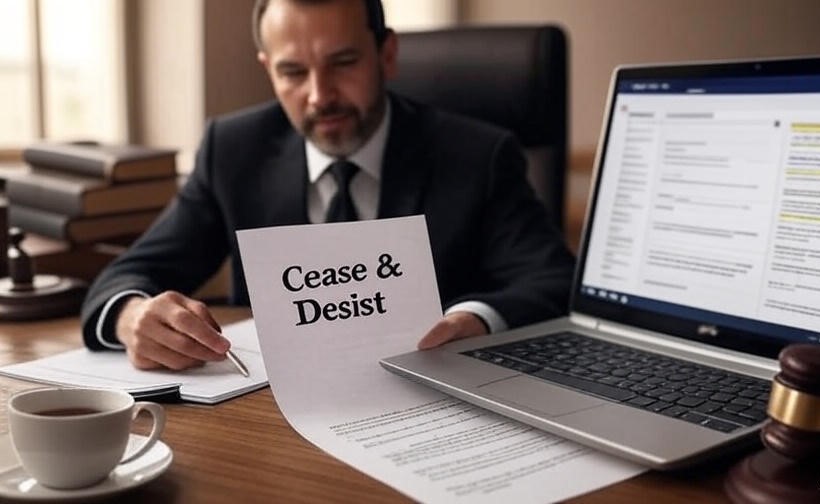If you’ve ever received a formal letter demanding that you stop certain actions immediately, you know it can be unsettling. Whether it’s about a business dispute, an alleged copyright infringement, or an accusation of defamation, such communications—known as legal notices or cease & desist letters—carry weight.
The first reaction for many people is fear or confusion. But here’s the truth: not all such letters mean you’re about to be dragged into court. Some are legitimate, others may be baseless. The key is knowing how to handle legal notices and cease & desist letters strategically.
This guide offers a detailed, step-by-step approach to understanding what these letters are, why they’re used, how to respond as a recipient, how to draft them as a sender, and the legal implications involved. It is intended for informational purposes only and should not replace professional legal advice.
Table of Contents
Toggle1. Understanding the Basics
1.1 What Is a Legal Notice?
A legal notice is a formal communication sent to notify an individual or organization of a legal grievance or demand. It is often the first step in the formal dispute process, alerting the recipient of alleged wrongdoing and giving them an opportunity to take corrective action before litigation.
1.2 What Is a Cease & Desist Letter?
A cease & desist letter is a specific type of legal notice that demands the recipient stop engaging in certain conduct immediately and refrain from it in the future. It is used across a wide range of disputes, such as:
-
Intellectual property violations – e.g., trademark infringement, copyright misuse, patent breaches.
-
Defamation – spreading false statements that harm a person or business.
-
Contract breaches – failing to meet obligations under a signed agreement.
-
Harassment or stalking – unwanted contact or intimidation.
-
Trespass or nuisance – unlawful entry onto property or causing disturbance.
1.3 How They Differ from Court Orders
Neither a legal notice nor a C&D letter is an enforceable court order. They are warnings or demands, but compliance is voluntary unless a court issues an injunction or judgment.
2. Why Cease & Desist Letters Are Used
C&D letters serve several functions:
-
Prevent Escalation – Often, disputes can be resolved quickly if the other party is made aware of the problem and the seriousness of the claim.
-
Establish a Paper Trail – Documenting demands can be useful if the matter proceeds to court.
-
Show Legal Intent – Courts may look favorably on a party who attempted to resolve a dispute before litigation.
-
Trigger Compliance – Many recipients prefer to comply rather than face costly legal proceedings.
-
Strategic Negotiation Tool – A well-crafted letter can lead to a settlement or licensing agreement.
3. Anatomy of a Cease & Desist Letter
While formats vary, most professional C&D letters contain:
-
Sender Information – Full name, address, and contact details, often on law firm letterhead for credibility.
-
Recipient Details – Accurate identification of the person or business allegedly at fault.
-
Statement of Facts – A factual description of the conduct in question.
-
Legal Basis – Citations to laws, contracts, or rights allegedly violated.
-
Demand for Action – Clear instructions on what the recipient must stop doing.
-
Deadline for Compliance – A specific date by which action must be taken.
-
Consequences of Non-Compliance – A warning of potential lawsuits, injunctions, or damages.
-
Proof of Delivery – Sent by certified mail, courier, or other trackable method.
4. How to Handle Legal Notices and Cease & Desist Letters as a Recipient
If you’ve received such a letter, following the right steps is crucial.
4.1 Stay Calm and Avoid Rash Decisions
Panicking or reacting emotionally can lead to costly mistakes. Do not respond immediately or destroy evidence.
4.2 Verify Authenticity
-
Confirm the sender’s identity.
-
Check whether the claims relate to real events or your activities.
-
See if it comes from a licensed lawyer or directly from the complainant.
4.3 Read the Letter Carefully
Identify:
-
The alleged wrongful conduct.
-
The legal basis for the complaint.
-
The timeframe and deadlines.
-
Any evidence or documentation attached.
4.4 Gather Evidence
Collect all relevant records—emails, contracts, receipts, photographs—that may support your case or contradict the allegations.
4.5 Seek Legal Advice Promptly
A qualified lawyer can:
-
Assess the strength of the claims.
-
Advise on whether to comply, negotiate, or contest.
-
Draft a formal response.
Even if you think the letter is baseless, legal guidance is critical.
4.6 Consider Your Options
-
Comply Fully – If the claims are valid and compliance is low-cost.
-
Negotiate – Modify terms, such as entering a licensing agreement.
-
Refute the Claims – Provide counter-evidence in a formal response.
-
Ignore the Letter – Only after legal advice and if the risk is minimal.
4.7 Respond Professionally
If you respond, keep it factual, concise, and free from admissions unless advised otherwise. Maintain copies for your records.
5. How to Draft a Cease & Desist Letter as
If you are protecting your rights, a C&D letter should be carefully crafted.
5.1 Gather Evidence First
Your claim should be supported by clear proof—documents, images, or witness statements.
5.2 Use a Professional Format
-
Begin with the sender’s details and date.
-
Clearly identify the recipient.
-
State the facts chronologically.
-
Cite the legal basis for your claims.
5.3 Set a Reasonable Deadline
Deadlines are typically 7–14 days but may vary based on urgency.
5.4 Avoid Threatening Language
Aggressive or defamatory statements can backfire. Keep it firm but respectful.
5.5 Send Through Trackable Means
Use certified mail, courier, or email with read-receipt confirmation.
6. Risks and Legal Implications
6.1 For Recipients
-
Escalation to Court – Ignoring a letter may result in legal proceedings.
-
Cost and Time – Defending against a lawsuit is expensive.
-
Reputation Damage – Some letters become public.
6.2 For Senders
-
Counterclaims – The recipient might sue for defamation or harassment.
-
Legal Costs – Pursuing enforcement can be costly.
-
Jurisdictional Issues – Different countries or states have different rules.
7. Best Practices for Both Parties
-
Keep all communication documented.
-
Maintain professionalism and avoid emotional exchanges.
-
Engage legal counsel early.
-
Respect set deadlines.
-
Consider mediation or alternative dispute resolution.
8. Jurisdictional Considerations
United States
C&D letters are common in intellectual property disputes. However, misuse can lead to “declaratory judgment” actions, where the recipient sues to prove they’ve done nothing wrong.
United Kingdom
Pre-action protocols apply. Defamation claims have strict requirements under the Defamation Act 2013.
Canada
Frequently used for IP disputes. Claims must align with federal statutes like the Copyright Act.
Australia
Misleading or overly threatening letters can violate consumer protection laws.
9. Step-by-Step Checklist for Recipients
-
Do not panic – Stay objective.
-
Verify authenticity – Check sender credentials.
-
Read thoroughly – Understand every allegation.
-
Gather evidence – Support your position.
-
Consult a lawyer – Get expert guidance.
-
Evaluate options – Comply, negotiate, contest, or ignore (rare).
-
Respond professionally – Use measured language.
-
Document everything – Keep a full record.
10. Step-by-Step Checklist for Senders
-
Confirm your rights – Be sure your claim is legally valid.
-
Collect strong evidence – Back every statement.
-
Draft with clarity – State facts in logical order.
-
Cite laws or contracts – Show legal grounding.
-
Avoid personal attacks – Keep tone professional.
-
Set a compliance deadline – Reasonable yet firm.
-
Send via trackable delivery – Have proof of receipt.
-
Keep a copy – Retain the final version for records.
11. Common Mistakes to Avoid
-
Responding emotionally or aggressively.
-
Admitting fault without legal advice.
-
Using vague or unclear demands.
-
Ignoring deadlines without strategy.
-
Failing to keep proof of communication.
12. Alternative Dispute Resolution Options
Before litigation, consider:
-
Mediation – A neutral third party helps find a resolution.
-
Arbitration – Binding or non-binding decision by an arbitrator.
-
Settlement Agreements – Formalizing agreed terms in writing.
FAQs
Q1: Is a cease & desist letter legally binding?
No. It is a warning, not an enforceable order. A court must issue a ruling for legal enforcement.
Q2: What happens if I ignore one?
You risk escalation to formal legal proceedings, which can be costly and time-consuming.
Q3: Can I write one without a lawyer?
Yes, but legal assistance adds credibility and ensures compliance with the law.
Q4: How quickly should I act after receiving one?
Immediately seek legal advice—preferably within 24–48 hours—to allow enough time to respond before the deadline.
Q5: Can sending a false C&D letter be illegal?
Yes. Misuse can lead to counterclaims for defamation, harassment, or malicious prosecution.
Conclusion
Knowing how to handle legal notices and cease & desist letters is critical for individuals and businesses alike. Whether you are sending one to protect your rights or receiving one and defending against allegations, a careful, strategic approach will protect your legal position and help avoid unnecessary costs.
By understanding the structure, purpose, and best practices for dealing with these communications, you position yourself to handle disputes effectively—reducing the risk of escalation and maintaining professionalism throughout the process.
If you want, I can now create an SEO metadata package for this article (meta title, description, and keyword integration report) so it’s ready to publish and optimized for Google ranking. Would you like me to prepare that?












